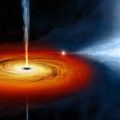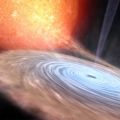
Researchers generate black hole ‘plasma fireballs’ on Earth
An international team of scientists, led by the Department of Physics at the University of Oxford, has developed a novel way to experimentally produce plasma ‘fireballs’ on Earth, opening up a new frontier in laboratory astrophysics. The new findings have been published this week in Nature Communications.
This opens up an entirely new frontier in laboratory astrophysics by making it possible to experimentally probe the microphysics of gamma-ray bursts or active galactic nuclei jets.
Lead author Charles Arrowsmith, Department of Physics, University of Oxford
Black holes and neutron stars are the most compact objects in the universe. Around these extreme astrophysical environments exist plasmas, the fourth fundamental state of matter alongside solids, liquids, and gases. The intense gravity of these dense objects pulls in nearby matter and also causes them to shoot out powerful jets of plasma, mainly made of pairs of electrons and their antimatter counterpart, positrons. While these jets are often seen in space, creating them in a laboratory has proved highly challenging so far.
Now, for the first time, an international team of scientists has successfully created high-density plasma beams in the lab containing around 10 trillion electron-positron pairs. Such a large number means that the beam behaves as a true plasma (with wave-like activity) and not just a collection of particles.
According to the researchers, this breakthrough opens the door to future experiments to explore the powerful processes happening in gamma-ray bursts, GRBs (highly energetic bursts of light thought to be caused by catastrophic events in outer space) and the outflows from active galactic nuclei, AGN (extremely bright regions at the centres of some galaxies powered by supermassive black holes).
‘The laboratory generation of plasma “fireballs” composed of matter, antimatter, and photons is a research goal at the forefront of high-energy-density science,’ says lead author Charles Arrowsmith, from the Department of Physics at the University of Oxford. ‘But the experimental difficulty of producing electron-positron pairs in sufficiently high numbers has, to this point, limited our understanding to purely theoretical studies.’
Along with researchers from the Rutherford Appleton Laboratory in Harwell, the group designed a novel experiment harnessing the HiRadMat facility at the Super Proton Synchrotron (SPS) accelerator at the European Organisation for Nuclear Research (CERN) in Geneva, Switzerland.
This achievement highlights the importance of both interaction with our colleagues in Physics and collaboration between experimental facilities around the world, especially as they break new ground in accessing increasingly extreme physical regimes.
Lead investigator Professor Gianluca Gregori, Department of Physics, University of Oxford
The experiment produced a huge amount of electron-positron pairs using 300 billion protons from the SPS accelerator. Each proton had 440 times more kinetic energy than its normal resting energy. Because of this, when these high-energy protons smashed into an atom, they had enough power to break apart the atom's components—quarks and gluons—which then quickly came back together to create a cascade of particles that eventually turned into electrons and positrons.
Essentially, the beam generated at CERN had enough particles to start behaving like a true astrophysical plasma around a black hole.
The team has also developed techniques to modify the emittance of pair beams, making it possible to perform controlled studies of plasma interactions in scaled analogues of astrophysical systems. This brings together researchers from across the Department of Physics, one of the largest in the world. Professor Gianluca Gregori and Dr Archie Bott from Atomic and Laser Physics, Professors Subir Sarkar and Alex Schekochihin from the Rudolf Peierls Centre for Theoretical Physics, and Professor Professor Todd Huffman from Particle Physics
Professor Gregori, lead investigator on the experiment, said: ‘Satellite and ground-based telescopes are not able to resolve the smallest details of distant gamma-ray bursts and active galactic nuclei outflows, and so far we could only rely on numerical simulations. This new approach will now enable us to test the predictions of sophisticated theoretical calculations, for instance to validate how cosmic fireballs interact with the interstellar plasma that exists between stars.’
The study ‘Laboratory realization of relativistic pair-plasma beams’ has been published in Nature Communications.
In addition to the University of Oxford, the Rutherford Appleton Laboratory and CERN, collaborating institutions on this research include the University of Rochester’s Laboratory for Laser Energetics (LLE), the Atomic Weapons Establishment, the Lawrence Livermore National Laboratory, the Max Planck Institute for Nuclear Physics, the University of Iceland, and the Instituto Superior Técnico in Portugal.
 New analysis of archaeological data reveals how agriculture and governance have shaped wealth inequality
New analysis of archaeological data reveals how agriculture and governance have shaped wealth inequality
 Cambridge victorious in Women's and Men's Boat Races 2025
Cambridge victorious in Women's and Men's Boat Races 2025
 Expert Comment: Ethical and legal challenges of uterus transplants in Mexico
Expert Comment: Ethical and legal challenges of uterus transplants in Mexico
 First proof that “plunging regions” exist around black holes in space
First proof that “plunging regions” exist around black holes in space
 Extraordinary new space phenomenon mystifies scientists
Extraordinary new space phenomenon mystifies scientists
 Major collaboration reveals new insights on binary star systems
Major collaboration reveals new insights on binary star systems